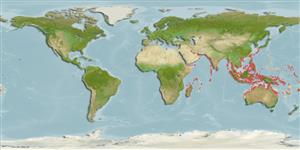Classification / Names
Noms communs | Synonymes | Catalog of Fishes(Genre, Espèce) | ITIS | CoL | WoRMS | Cloffa
>
Clupeiformes (Herrings) >
Engraulidae (Anchovies) > Engraulinae
Etymology: Encrasicholina: Greek, egkrasicholos, -os, -on = mixed with spleen.
More on author: Whitley.
Issue
formerly ENGR Stol 7
Environment: milieu / climate zone / depth range / distribution range
Écologie
marin; saumâtre récifal. Tropical; 32°N - 28°S, 43°E - 173°W (Ref. 189)
Indo-Pacific: widespread in the northern part of the Indian Ocean (Gulf of Aden, but apparently not the Red Sea nor Kenya, the Persian Gulf, India, Andaman Islands) and Western Central Pacific (Indonesia, Thailand, north to at least Taiwan Island, south to northern Australia; also eastward to Fiji and Tonga).
Length at first maturity / Taille / Poids / Âge
Maturity: Lm 6.1, range 4 - ? cm
Max length : 9.7 cm TL mâle / non sexé; (Ref. 55634); 10.0 cm TL (female); poids max. publié: 8.00 g (Ref. 55634); poids max. publié: 8.00 g
Épines anales: 0; Rayons mous anaux: 18 - 20. Diagnosis: Body rather cylindrical, belly rounded, with 5-6, rarely 3 or 4, sharp needle-like pre-pelvic scutes; maxilla tip pointed, projecting beyond second supra-maxilla and reaching to sub-operculum; isthmus short, preceded by a small bony plate on urohyal between branchial membranes; lower gillrakers 20-27; unbranched dorsal and anal finrays 3, anal fin short, with usually 15-17 branched finrays; in life, a bright silver band on flank, with a thin blue line above, back blue/grey (Ref. 189). It closely resembles Encrasicholina heteroloba, which has only 2 unbranched dorsal and anal finrays, a dull silver/grey band on flank, and the back beige; Encrasicholina oligobranchus has only 17-18 gillrakers; other species of Encrasicholina have a fleshy urohyal plate and a maxilla tip blunt and not projecting beyond the second supra-maxilla; species of Stolephorus have a long isthmus reaching to the margin of the branchial membrane (Ref. 189).
Whitehead, P.J.P., G.J. Nelson and T. Wongratana, 1988. FAO Species Catalogue. Vol. 7. Clupeoid fishes of the world (Suborder Clupeoidei). An annotated and illustrated catalogue of the herrings, sardines, pilchards, sprats, shads, anchovies and wolf-herrings. FAO Fish. Synop. 125(7/2):305-579. Rome: FAO. (Ref. 189)
Statut dans la liste rouge de l'IUCN (Ref. 130435)
Menace pour l'homme
Harmless
Utilisations par l'homme
Pêcheries: intérêt commercial mineur; appât: usually
Outils
Articles particuliers
Télécharger en XML
Sources Internet
Estimates based on models
Preferred temperature (Ref.
123201): 25.1 - 29.3, mean 28.5 °C (based on 3195 cells).
Phylogenetic diversity index (Ref.
82804): PD
50 = 0.5039 [Uniqueness, from 0.5 = low to 2.0 = high].
Bayesian length-weight: a=0.00550 (0.00464 - 0.00651), b=3.12 (3.08 - 3.16), in cm total length, based on LWR estimates for this species (Ref.
93245).
Niveau trophique (Ref.
69278): 3.3 ±0.1 se; based on diet studies.
Résilience (Ref.
120179): Haut, temps minimum de doublement de population inférieur à 15 mois (K=2.00-5.04; tm=0.29; tmax=1.7).
Prior r = 1.19, 95% CL = 0.79 - 1.79, Based on 1 data-limited stock assessment.
Fishing Vulnerability (Ref.
59153): Low vulnerability (10 of 100).
Nutrients (Ref.
124155): Calcium = 239 [65, 779] mg/100g; Iron = 1.47 [0.53, 3.85] mg/100g; Protein = 19.7 [17.2, 21.8] %; Omega3 = 0.207 [0.089, 0.481] g/100g; Selenium = 39.9 [12.9, 127.6] μg/100g; VitaminA = 37.5 [9.1, 191.7] μg/100g; Zinc = 2.21 [1.24, 5.33] mg/100g (wet weight); based on
nutrient studies.
